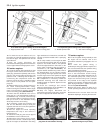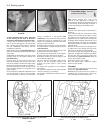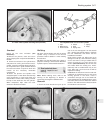
3 Hydraulic pipes and hoses -
renewal
2
Note: Before starting work, refer to the
warning at the beginning of Section 2
concerning the dangers of hydraulic fluid.
1 If any pipe or hose is to be renewed,
minimise hydraulic fluid loss by removing the
master cylinder reservoir cap, placing a piece
of plastic film over the reservoir and sealing it
with an elastic band. Alternatively, flexible
hoses can be sealed, if required, using a
proprietary brake hose clamp; metal brake
pipe unions can be plugged (if care is taken
not to allow dirt into the system) or capped
immediately they are disconnected. Place a
wad of rag under any union that is to be
disconnected, to catch any spilt fluid.
2 If a flexible hose is to be disconnected,
unscrew the brake pipe union nut before
removing the spring clip which secures the
hose to its mounting. Depending upon the
make of the particular caliper, the other end of
the hose may be connected simply by
screwing it into its tapped hole or by using a
hollow bolt with banjo end fitting. Use a new
copper sealing washer on each side of the
banjo union.
3 To unscrew the union nuts, it is preferable to
obtain a brake pipe spanner of the correct size;
these are available from most large motor
accessory shops. Failing this, a close-fitting
open-ended spanner will be required, though if
the nuts are tight or corroded, their flats may be
rounded-off if the spanner slips. In such a case,
a self-locking wrench is often the only way to
unscrew a stubborn union, but it follows that
the pipe and the damaged nuts must be
renewed on reassembly. Always clean a union
and surrounding area before disconnecting it. If
disconnecting a component with more than
one union, make a careful note of the
connections before disturbing any of them.
4 If a brake pipe is to be renewed, it can be
obtained, cut to length and with the union
nuts and end flares in place, from Peugeot
dealers. All that is then necessary is to bend it
to shape, following the line of the original,
before fitting it to the car. Alternatively, most
motor accessory shops can make up brake
pipes from kits, but this requires very careful
measurement of the original, to ensure that
the replacement is of the correct length. The
safest answer is usually to take the original to
the shop as a pattern.
5 Before refitting, blow through the new pipe
or hose with dry compressed air. Do not
overtighten the union nuts. It is not necessary
to exercise brute force to obtain a sound joint.
6 If flexible rubber hoses are renewed, ensure
that the pipes and hoses are correctly routed,
with no kinks or twists, and that they are
secured in the clips or brackets provided.
7 After fitting, bleed the hydraulic system as
described in Section 2, wash off any spilt
fluid, and check carefully for fluid leaks.
4 Front brake pads - renewal
2
Warning: Disc brake pads must
be renewed on both front
wheels at the same time - never
renew the pads on only one
wheel as uneven braking may result. Dust
created by wear of the pads may contain
asbestos, which is a health hazard. Never
blow it out with compressed air and do not
inhale any of it. DO NOT use petroleum-
based solvents to clean brake parts. Use
brake cleaner or methylated spirit only. DO
NOT allow any brake fluid, oil or grease to
contact the brake pads or disc. Also refer
to the warning at the start of Section 2
concerning the dangers of hydraulic fluid.
All models except 1.9 GTI
1 Chock the rear wheels then jack up the
front of the car and support it on axle stands
(see “Jacking and vehicle support”). Remove
the front roadwheels.
2 Note that two different types of brake
caliper may be fitted according to model and
year. Identify the type fitted, with reference to
the accompanying illustrations or the caliper
itself, then proceed as described under the
relevant sub-heading.
DBA Bendix caliper
3 Remove the clip from the end of the upper
sliding key. Disconnect the pad wear wiring
connector as necessary (see illustrations).
4 Pull out the upper sliding key (see
illustration).
5 Using a lever against the front suspension
strut, push the cylinder towards the brake disc
so that the outer pad can be withdrawn from
the caliper (see illustration).
6 Push back the caliper and withdraw the
inner pad (see illustration). Make a note of
the correct fitted position of the anti-rattle
springs and remove the spring from each pad.
7 Clean away all dust and dirt from the
caliper. Check for brake fluid leakage around
the piston dust seal and, if evident, overhaul
the caliper, as described later in this Chapter.
Check the brake disc for wear and also check
that the rubber bellows on the cylinder sliding
rods are in good condition.
8 Clean the backs of the brake pads and
apply a little anti-squeal brake grease. Also
apply the grease to the lower pad locating lip
of the caliper.
9•4 Braking system
4.3a Pad sliding key clip - arrowed
(DBA Bendix caliper)
4.3b Disconnecting the pad wear wiring
connector (DBA Bendix caliper)
4.4 Removing the pad sliding key
(DBA Bendix caliper)
4.5 Removing the outer pad
(DBA Bendix caliper)
4.6 Removing the inner pad
(DBA Bendix caliper)


















